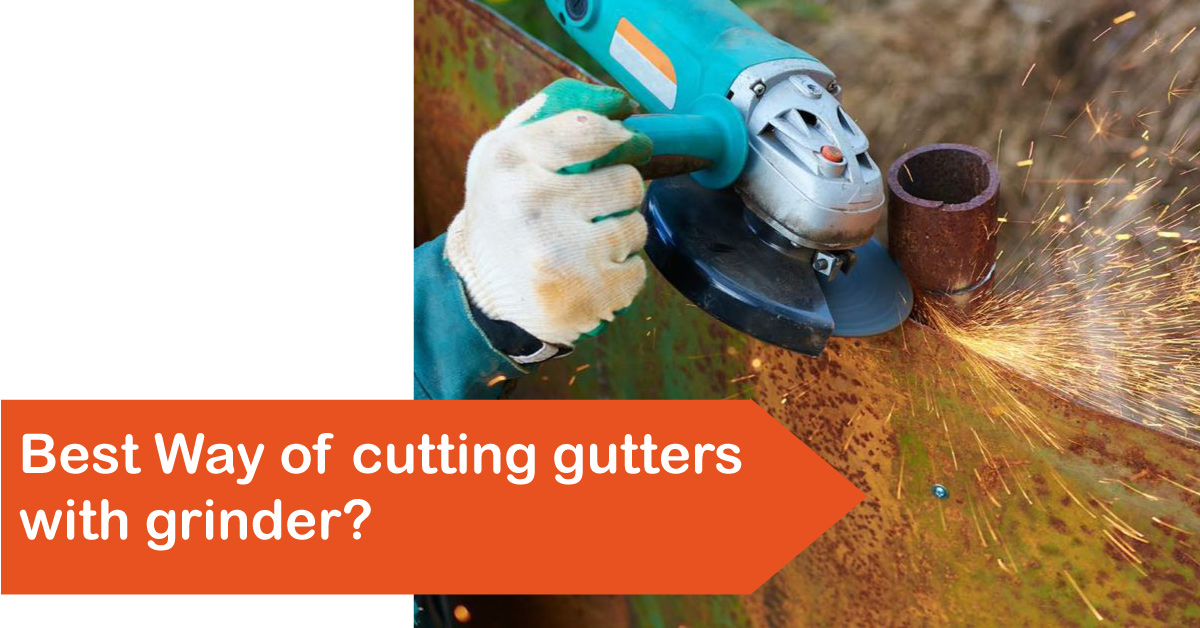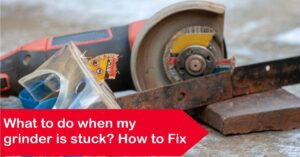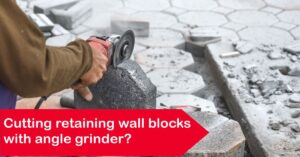Generally, gutters are very important for protecting the roof and wall of a house which is considered a crucial part of a house. For proper function, regular maintenance is necessary for gutters. By using a grinder, we can cut trenches to a proper length.
Cutting gutters with a grinder is a quick and effortless way. But safety when cutting gutters is a key consideration. You need to be cautious of sharp edges that could sever you like a razor blade in addition to the instruments that you are employing.
How to Cut Gutters with Grinder?
You need the proper method of cutting gutters with a grinder. No matter what equipment you use, you can cut gutters correctly by following this technique. The ways to cut gutters in a perfect way are discussed below:
Setting up the area: Establishing a work area—a table or bench, for example: is the first step in the procedure. For this purpose, there are numerous portable solutions.
Upside-Down measurement:After positioning the gutter on the table upside-down, you can measure and mark it. A single mark is sufficient if you’re using a miter saw or another saw that cuts through it smoothly. If not, a combination square can be used to mark the gutter’s perimeter.
Change the Gutter:At this stage, you want the gutter to be turned over so you can handle it easily.
Trim the Gutters: Regardless of whether you’re using a hacksaw, tin snips, or a miter saw, the gutter needs to be cut at this point. Cut from top to bottom through the gutter. You should slightly bend the bottom gutter to expose it if you’re using tin snips or a hacksaw.
File: Use a file to remove any remaining sharp edges so that the cut is clean and your hands are protected.
Grinder Types
While selecting a grinder for cutting, keep in mind the size and the type of work we will do with it. An angle grinder is an ideal choice for cutting gutters for most jobs because of its adaptability and simplicity. But a bench grinder would be a better option if you’re working with huge, intricate gutters.
Different types of grinders and their uses are discussed below:
Bench Grinder: A bench grinder is a stationary power instrument for sharpening and sculpting metal. It can be used to cut gutters with the proper blade, albeit less versatile than an angle grinder.
Angle Grinder: A multipurpose hand-held power tool, an angle grinder can be used for cutting, grinding, and polishing. Because of its small size and ability to produce precise cuts, it’s a common option for cutting gutters.
Rotary Tool: A rotary tool is a small, portable power tool used frequently for precise work. Little gutter portions can be cut with it, although it is less powerful than an angle grinder or bench grinder.
Belt Grinder: A stationary power instrument called a belt grinder uses a belt to sand or grind materials. It’s a common option for metalworking, but it may also be used to cut gutters with the correct blade. It’s a good choice for more demanding cutting operations that call for control and precision.
Die Grinder: A portable power instrument called a die grinder is frequently used for metal grinding and polishing. But, it can also be used to cut gutters if the proper attachment is utilized. It’s a wonderful alternative for little cutting jobs that need control and accuracy.
Cut-Off Grinder: A chop saw, often referred to as a cut-off grinder, is a strong tool made for quickly cutting through resistant materials. It has a sizable cutting wheel and can easily create precise cuts. However, it is less adaptable than an angle grinder and is most effective for heavy-duty cutting jobs.
Types of blades available for cutting gutters
There are different types of blades available for cutting gutters. Some of them are mentioned below:
Diamond Blade: A cutting blade with diamond segments embedded in the edge is known as a diamond blade. It’s an excellent option for slicing through strong materials like gutters made of concrete, brick, and stone. Diamond blades are preferred for experts due to their strength and ability to withstand demanding cutting operations.
Abrasive Blade: Abrasive particles like silicon carbide or aluminum oxide are used to create a specific type of cutting blade known as an abrasive blade. It works well for slicing through softer materials like wood and plastic as well as gentler ones like aluminum gutters. Compared to diamond or carbide-tipped blades, abrasive blades are less expensive, but they may not last as long.
Metal-Cutting Blade: A blade specifically made for cutting through metal gutters is known as a metal-cutting blade. It has high-speed steel or carbide teeth and can cut through difficult materials. Angle grinders and bench grinders work best with metal-cutting blades.
Carbide-Tipped Blade: An instrument for cutting with tungsten carbide teeth is known as a carbide-tipped blade. This kind of blade works well for cutting through masonry and some kinds of stone, as well as metal gutters. It costs less than a diamond blade while providing superior cutting performance and durability.
Safety Issues should be considered
- Guards must be installed and set up according to the manufacturer’s handbook to protecting you. Because an abrasive wheel breaking while turning can result in a serious injury, replace broken guards.
- The maximum speed at that it can be used should be determined before usage by referring to the manufacturer’s recommended running speeds or markings on the grinder and grinder wheel.
- For the safest usage of grinder wheel guards, adhere to the manufacturer’s instructions.
- Grinders should be cleaned and serviced in accordance with manufacturer guidelines. Keep a record of all grinder maintenance.
- Check the dead-man switch to make sure a machine won’t run when left unattended.
- To shield yourself from flying objects, put on safety goggles, safety glasses, or a face shield. Depending on the job, gloves, aprons, metatarsal safety boots, hearing protection, and breathing protection may be needed.
- Make sure the space surrounding the work area is spotless.
- Choose only smooth wheels; avoid using ones that vibrate too much or have cracks in them.
- Grinders shouldn’t be used on wet flooring.
- Hold the grinder with both hands.
- Keep the power cable away from the material being ground and the grinding wheel.
- Have a hot work permit in place when necessary before using.
- Ensure sure there are no flammable materials in the work area and that combustible dust is not allowed to build up.
- To shield yourself from flying objects, put on safety goggles, safety glasses, or a face shield. Depending on the job, gloves, aprons, metatarsal safety boots, hearing protection, and breathing protection may be needed.
- Make sure the space surrounding the work area is spotless.
- Choose only smooth wheels; avoid using ones that vibrate too much or have cracks in them.
- Grinders shouldn’t be used on wet flooring.
- Hold the grinder with both hands.
- Keep the power cable away from the material being ground and the grinding wheel.
- Have a hot work permit in place when necessary before using.
- Ensure there are no flammable materials in the work area and combustible dust is not allowed to build up.
Pros and cons of grinder
Pros
- Generally grinder gives a perfectly fine cut along with accurate measurements
- A grinder can cut gutters very quickly which can save time.
- Different types material of gutters are cut by grinder like PVC,Steel, aluminum, etc
- Grinders are comparatively more affordable than other cutting tools.
Cons
- Sometimes using a grinder becomes dangerous while cutting gutters. There remains a risk of being injured.
- Grinder makes a loud noise which causes noise pollutants.
- A lot of dust is dust can be found while using a grinder which can cause harmful health hazards
- If you are not skilled, then you can’t use the grinder properly it can be dangerous so it requires skill.
FAQ
Q1.Which grinder is most effective for cutting gutters?
The most effective grinder for cutting gutters is often an angle grinder with a metal-cutting blade. The grinder size should match the size of the gutter being cut, with a smaller grinder better suited for cutting more undersized gutters and a larger grinder more suited for cutting more oversized gutters.
Q2.Before using a grinder to cut the gutter, how should I measure and mark it?
Mark the gutter’s length with a pencil or chalk after measuring how long it has to be cut. To ensure accuracy, double-check your measurement before cutting.
Q3.Which gutter kinds can be trimmed with a grinder?
A grinder can cut through different gutter materials like PVC, steel, and aluminum.
Q4.What is the finest equipment to cut guttering?
Use a hacksaw to rapidly cut through gutters. When a miter saw could be deemed excessive, they are also useful for making finer cuts. A hacksaw’s blade can be changed depending on whether you’re cutting through metal or plastic because the blade is replaceable.
Q5.Which method of cutting metal pipe is best?
Although reciprocating saws or angle grinders may be required for tight spaces, heavy-duty steel pipe and tube cutters are typically the simplest to handle.
Conclusion
Using a grinder to cut gutters can be a quick and efficient technique to cut gutter materials precisely. To prevent harm and maintain precision, it’s crucial to use the appropriate grinder and blade, take safety precautions, and adhere to the necessary procedures.
All sharp edges must be filed down or smoothed off with sandpaper to avoid injury or harm to the gutter system. Cutting gutters with grinder can be beneficial for home repair jobs, even though there are some potential downsides, such as noise and dust.




